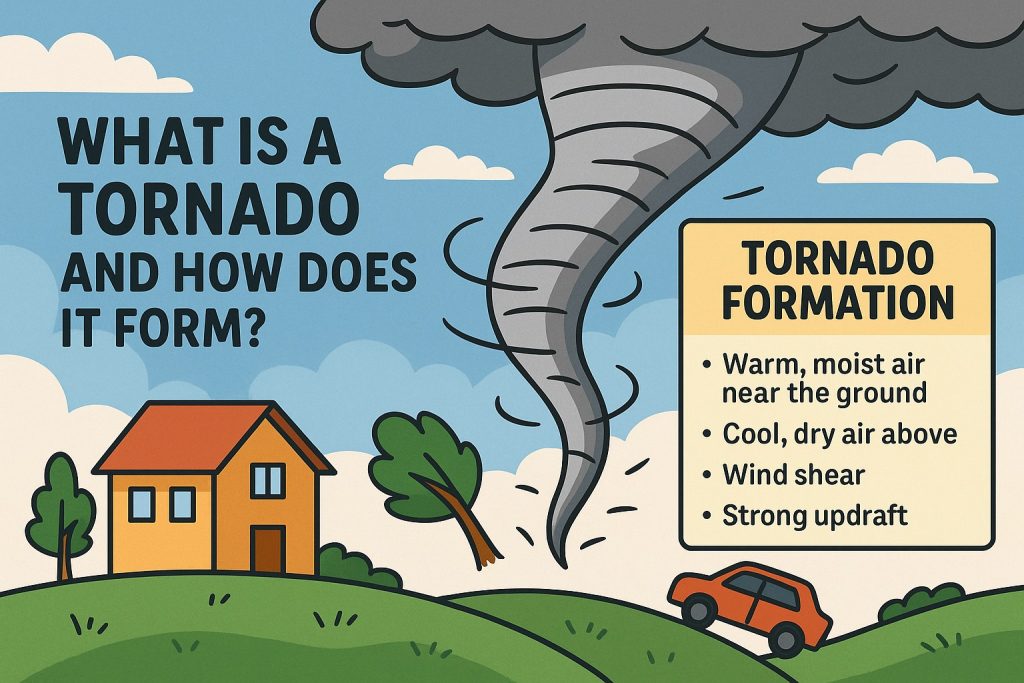A tornado is a violently rotating column of air that extends from the base of a thunderstorm to the ground. It is one of nature’s most intense weather phenomena, capable of destroying buildings, uprooting trees, and hurling vehicles with its immense power. Understanding how tornadoes form helps scientists improve forecasts and communities prepare for emergencies.
What Exactly Is a Tornado?
Tornadoes are rapidly spinning funnels of air that form during specific atmospheric conditions. They can vary in size, strength, and duration — from narrow, weak funnels that last a few minutes to wide, destructive storms that persist for over an hour.
Most tornadoes are relatively short-lived and localized, but the strongest ones can reach wind speeds of over 300 km/h (200 mph) and leave paths of devastation several kilometers wide and long.
How Do Tornadoes Form?
Tornado formation requires several key ingredients:
- Warm, moist air near the ground.
- Cool, dry air above.
- Wind shear — changing wind direction and speed with altitude.
- Strong updrafts, usually within a supercell thunderstorm.
Here’s how it typically happens:
- Warm, moist air rises and meets cooler, dry air above, creating instability.
- Wind shear causes the rising air to begin rotating horizontally.
- A strong updraft then tilts this rotation vertically.
- If this rotating column of air becomes concentrated and stretches downward, a funnel cloud forms.
- Once the funnel touches the ground, it becomes a tornado.
Where Are Tornadoes Most Common?
Tornadoes occur worldwide but are most frequent and severe in Tornado Alley — a region in the central United States that includes Texas, Oklahoma, Kansas, and Nebraska. Conditions there are ideal for the collision of warm Gulf air and cool Rocky Mountain air.
Other countries that experience tornadoes include Canada, Argentina, Bangladesh, Russia, and Australia.
The Fujita Scale: Measuring Tornado Strength
Tornadoes are ranked using the Enhanced Fujita (EF) Scale, which estimates wind speed based on observed damage:
- EF0: 105–137 km/h – light damage
- EF1: 138–177 km/h – moderate damage
- EF2: 178–217 km/h – considerable damage
- EF3: 218–266 km/h – severe damage
- EF4: 267–322 km/h – devastating damage
- EF5: >322 km/h – incredible destruction
The vast majority of tornadoes are EF0 or EF1, but EF4 and EF5 events can be catastrophic.
Safety During a Tornado
To stay safe during a tornado:
- Seek shelter in a basement or interior room without windows.
- Avoid cars and mobile homes, which are easily overturned.
- Listen to weather alerts and tornado warnings via radio, TV, or mobile apps.
- If there is no shelter nearby, go to a low-lying area such as a ditch or ravine and lie flat. Protect your head and neck with an object or with your arms. Avoid areas with many trees.
Preparedness saves lives. Have an emergency kit and a plan in place if you live in a tornado-prone area.
Glossary
- Tornado — A rotating column of air connecting a thunderstorm to the ground.
- Wind shear — Variation in wind speed or direction with height.
- Supercell — A type of severe thunderstorm with strong rotation and potential for tornadoes.
- Funnel cloud — A visible rotating column of air that hasn’t touched the ground yet.
- Enhanced Fujita Scale — A system for classifying tornadoes by intensity and damage.


